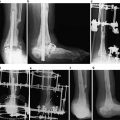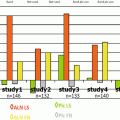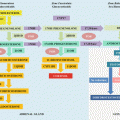Benign nodular goiter
Thyroiditis
Cysts
Primary thyroid cancer
Papillary carcinoma
Follicular carcinoma
Hurtle cell carcinoma
C-cell derived carcinoma, Medullary carcinoma
Anaplastic carcinoma
Metastatic Cancer
Lymphoma
Family history should be obtained, paying special attention to a history of medullary thyroid carcinoma (MTC), papillary thyroid carcinoma, multiple endocrine neoplasia types 2A and 2B, familial polyposis disease, Cowden disease, Carney complex, Gardner syndrome, and other rare diseases [10–13]. Table 4.2 shows findings suggestive of increased risk of malignancy potential.
Table 4.2
Findings of increased malignancy potential
Prior history of head and neck irradiation |
Family history of MTC, MEN type 2, PTC, or other syndromes |
Age <14 or >70 years |
Male sex |
Growing nodule, firm or hard consistency, fixed |
Cervical adenopathy |
Persistent dysphonia, dysphagia, dyspnea, or vocal cord paralysis |
Diagnostic Evaluation
Serum Markers
Besides a complete history and physical exam all patients should undergo a serum TSH level measurement [14, 15]. If the TSH is low a thyroid scintigraphy should be performed to determine the functional status of the nodule as low TSH suggests overt or subclinical hyperthyroidism, hyperfunction (“hot”), and autonomous functioning adenoma. If indeed the nodule is found to be “hot” it is unlikely to be malignant and FNA should be deferred [16].
On the other hand, a low TSH can be secondary to Hashimoto’s thyroiditis and these patients can also present with a “pseudonodule” due to focal lymphocytic infiltration. TPO antibodies can be helpful in the diagnosis. In this case abnormal thyroid function does not exclude thyroid cancer and if a true nodule is found further investigation is needed. TSH levels are independent predictors of malignancy in patients with thyroid nodules: the risk of malignancy increases as the TSH levels also increases [17, 18].
Calcitonin is a marker for detection of C-cell hyperplasia and MTC, and levels >10 pg/mL have high sensitivity for the detection of MTC. Calcitonin should be measured in patients with family history of or high clinical suspicion of MTC or MEN 2 syndromes. Overall, the prevalence of MTC cancer in the USA is low and current ATA guidelines do not recommend “either for or against routine measurement” [14]. On the other hand, AACE guidelines state that measurement of basal serum calcitonin “may be useful as initial tool for evaluation of thyroid nodules” [15].
Other tests including serum calcium, PTH, serum thyroglobulin are neither sensitive nor specific so they are currently not recommended as routinely for the initial evaluation of thyroid nodule [14].
Imaging Studies: Ultrasound
Ultrasonography, more sensitive than palpation, is the imaging of choice to detect thyroid nodules. Thyroid ultrasound (US) should be performed in all patients with a suspected thyroid nodule, a goiter, or after an incidentally found nodule by other imaging modalities. Thyroid US is noninvasive, inexpensive, has a sensitivity of 95 % and can identify nodules usually not palpated on the physical exam. Ultrasound provides a very good evaluation of nodule size, dimensions, structure, and any possible suspicious features. It can also differentiate solid from cystic nodules [14, 15, 19].
Several US features can be suggestive of malignancy: microcalcifications, irregular borders, hypoechogenicity, taller-than-wide shape, and increased vascularity. These characteristics have high specificity but the positive predictive value is lowered by their relatively low sensitivity [20–22]. See Table 4.3 for details. None of these features alone is enough to differentiate a benign from malignant lesion [23]. Findings such isoechogenicity and spongiform appearance are features of benignity [22]. Suspicious cervical adenopathy without hilus, cystic changes, microcalcifications, and hypervascularity have a high probability for malignancy [24]. Complex nodules with solid and cystic components often with a dominant cystic part are frequently benign.
Table 4.3
Predictive value of ultrasonographic features in detection of thyroid cancer
Ultrasound feature | Sensitivity (%) | Specificity (%) |
|---|---|---|
Microcalcifications | 52 (26–73) | 86 (69–96) |
Absence of halo | 66 (46–100) | 54 (30–72) |
Irregular margins | 55 (17–77) | 79 (63–85) |
Hypoechogenicity | 81 (49–90) | 53 (36–66) |
Increased vascularity | 67 (57–74) | 81 (49–89) |
Numbers of nodules and size are not predictive of malignancy. In a gland with multiple nodules the selection for FNA should be based on the US features rather than size alone. Cancer is not less frequent in small nodules so diameter cutoff alone to evaluate cancer risk is not recommended [20, 25].
Screening of thyroid nodules by US or any other type of images is not recommended in the general population due to slow growth and minimal aggressiveness of thyroid cancers. Ultrasound should only be performed in patients with known or suspected thyroid nodules or presence of risk factors [14]. Advances in diagnostic imaging have improved the management of thyroid nodules, but it is also associated with the discovery of very small thyroid nodules (incidentalomas) of questionable and indeterminate clinical importance.
Imaging Studies: Others
Other techniques like MRI and CT scan are not recommended as routine tests as they are expensive and rarely diagnostic. CT scan and MRI have more value to assess size, substernal extension or extension to surround structures. Iodine contrast should be avoided as it decreases subsequent iodine 131 uptake [15]. Thyroid scintigraphy should be performed when there is suspicion of autonomy of the nodule (low TSH) suggesting overt of subclinical hyperthyroidism.
Fine Needle Aspiration Biopsy
Ultrasound-guided fine needle aspiration (FNA) is the procedure of choice in the evaluation of thyroid nodules and is the most accurate test for determining malignancy [4, 14, 15]. It is safe, cost-effective, and preferred over palpation-guided leading to much lower rates of nondiagnostic and false-negative cytology results [26].
Biopsy may cause mild, transient pain or hematoma. Neither other serious adverse effects nor seeding of tumor is reported [4]. Ultrasound guidance is very helpful in selecting the proper target for FNA, especially when nodules are <1 cm, cystic or impalpable. In multinodular goiters, if nodules have benign sonographic appearances, often FNA of the largest nodule may be sufficient. When performed by experienced physicians, adequate sample can be obtained from solid nodules in 90–97 % of aspirations [26]. There is no single ultrasound characteristic of malignancy but instead a combination of features that need to be evaluated as predictors of malignancy [4].
Cytology
Thyroid FNA slides should be reviewed by a cytopathologist with experience in thyroid. FNA has reduced the number of surgical procedures in patients with nodules by more than 50 % and substantially increased the malignancy yield at thyroidectomy [27]. An adequate sample is highly accurate for diagnosing thyroid cancer. Biopsy results may be classified as satisfactory or unsatisfactory (non-diagnostic). To be considered diagnostic or satisfactory the aspirate needs to contain no less than six groups of well-preserved thyroid epithelial cells consisting of at least ten cells in each group [28].
The new Bethesda FNA classification has five diagnostic categories: benign (70 %); malignant (5 %); and suspicious for malignancy including follicular or Hürthle cell neoplasm, follicular lesions of undetermined significance or atypia, representing 25 %. See Table 4.4 for details [28].
Table 4.4
The Bethesda system for reporting thyroid cytopathology: implied risk of malignancy and recommended clinical management
Diagnostic category | Risk of malignancy (%) | Usual management |
|---|---|---|
Nondiagnostic or unsatisfactory | 1–4 | Repeat FNA with ultrasound guidance |
Benign | 0–3 | Clinical follow-up |
Atypia of undetermined significance or follicular lesion of undetermined significance | 5–15 | Repeat FNA |
Follicular neoplasm or suspicious for a follicular neoplasm | 15–30 | Surgical lobectomy |
Suspicious for malignancy | 60–75 | Near-total thyroidectomy or surgical lobectomy |
Malignant | 97–99 | Near-total thyroidectomy |
Overall, 10 % of the FNAs will be unsatisfactory (non-diagnostic), usually because of sampling error or poor technique. Biopsy should be repeated but approximately 7 % of these nodules will still be unsatisfactory [14, 29–32]. The false-negative result range from 1 to 11 % but usually will be less than 5 % in most clinics with enough FNA experience [31, 33].
Management, Therapy, and Follow-up
Benign Thyroid Nodule
The most common benign lesions include colloid nodule, macrofollicular adenoma, benign cyst, and lymphocytic thyroiditis. The majority of these nodules do not need specific treatment once malignancy and abnormal thyroid function are excluded [1, 4, 14, 34].
If patient reports local symptoms including dysphagia, choking, dysphonia, dyspnea, or pain, surgical treatment may be warranted. The clinician should make sure that the symptoms are caused by the thyroid mass or enlargement, and not due to other processes such pulmonary, cardiac, esophageal disorders [4]. Patients with a single toxic nodule or a toxic multinodular goiter may be treated with surgery or radioiodine. Treatment with 131I for large toxic nodules is not preferred as usually these nodules require high doses and are associated with more side effects [15].
As the rate of growth of benign thyroid lesions is usually slow, observation usually is the plan of care. FNA-benign thyroid nodules will require long-term follow-up, because some may increase in size and there is always the fear of false-negative FNAs, reported at 1–5 % [35]. Clinical and ultrasound follow-up should be performed at 6–18 months, and periodically thereafter [4, 5].
The need for repeating FNA is a matter of debate. The American Thyroid Association recommends that if the nodule size is stable (no more than a 50 % change in volume or <20 % increase in at least two nodules dimensions in solid nodules or in the solid portion of mixed cystic-solid nodules) the interval before the next follow-up clinical examination or ultrasound may be extended [14]. The American Association of Clinical Endo-crinologists has a very similar approach [15].
Routine use of T4 suppressive therapy in the nodular thyroid disease is not recommended [14, 15]. In young patients with small nodules, colloid features on cytology, and living in iodine-deficient geographic areas, or those with nodular goiters and no evidence of functional autonomy, levothyroxine or iodine supplementation may be considered [36, 37]. Therapy with levothyroxine may be associated with increased risk of atrial fibrillation, other cardiac abnormalities, and reduced bone density, so the therapy should be avoided in patients with large nodules, long-standing goiters, low TSH levels, postmenopausal women, and men older than 60 years [38–40].
Malignant Thyroid Nodule
If cytologic results are positive for primary thyroid malignancy then surgery is almost always indicated [14, 15]. Metastatic disease to the thyroid needs further investigation to find the primary lesion and usually this precludes immediate surgery. Full workup should also be performed for anaplastic carcinoma and lymphoma [15]. If FNA suggests papillary thyroid cancer a near-total or total thyroidectomy is the procedure of choice, usually including removal of the lymph nodes within the central compartment (level 6), except in cases of intrathyroidal papillary microcarcinoma with no evidence of nodal involvement [3, 14, 15]. In patients with solitary, small (<1 cm) nodule without lymph node involvement proved to be PTC (preoperative or by frozen section) lobectomy plus isthmectomy may be sufficient [14, 15]. Consultation with an experienced endocrine surgeon is preferred and should be done as soon as possible.
Indeterminate Thyroid Nodule
This group carries the most challenging diagnostic dilemma. In this category a clear cytologic diagnosis cannot be made. Some examples include follicular neoplasms, Hürthle cell neoplasm, atypical PTC, or lymphoma. Nowadays the most acceptable approach is to perform diagnostic surgery to establish a histopathological diagnosis but only 10–40 % of these cases will be malignant, leading to unnecessary surgery with additional costs and risks [41].
Patients with cytology results suspicious for papillary thyroid carcinoma should undergo to surgery as the risk of malignancy is more than 60 % [15, 42]. On the final pathologic analysis most of these lesions will indeed be papillary thyroid carcinoma [28].
Follicular neoplasm, Hürthle cell neoplasm can be found in 15–30 % of FNA cases and carry up to 30 % malignant risk. Atypia or follicular lesion of undetermined significance usually has a lower risk of malignancy, around 5–10 % (Table 4.4) [14, 28, 43]. Repeat biopsy of these nodules is not recommended as can create confusion and often will not provide any additional useful information [15]. Certain clinical features such as male sex, nodules larger than 5 cm, older patient, presence of atypia can improved the diagnostic accuracy for malignancy but overall the predictive values are still low [44–46].
Most physicians when the diagnosis is in question will lean toward surgical intervention. In recent years several molecular and immunohistochemical markers have become available to improve the accuracy of cytologic diagnosis [14, 15, 47]. In practice, the majority of the thyroid nodules do not contain these mutations so surgery is not avoided. Recently, a published study showed that a new gene-expression test may identify low-risk thyroid nodules in indeterminate aspirates but even though with this approach 5–10 % of the nodules classified as benign (false negative) will be malignant, particularly on the group suspicious for malignancy [48]. The key question is to know if these new tests will be able to reduce unnecessary surgeries. If these new tests are able to reduce surgery for indeterminate cytology nodules by one third even with the additional cost of the test we may be able to reduce the overall expenses substantially [49].
Current guidelines describe these tests as expensive and still restricted. There is still lack of evidence and the use of routine use of these markers in clinical practice is still not recommended [15]. Most of the time surgical excision of these lesions is recommended. The initial step usually is a thyroid lobectomy and isthmectomy followed by completion of thyroidectomy depending of the histopathological result.
Non-diagnostic
Patients with nondiagnostic biopsies are those that do not meet specified criteria (the presence of at least six follicular cell groups, each containing 10–15 cells derived from at least two aspirates of a nodule) [28]. If initial FNA biopsy is nondiagnostic it should be repeated [15]. Most persistently nondiagnostic solid nodules should be surgically excised. A repeat FNA after initial nondiagnostic cytology may yield a 75 % diagnostic cytologic in solid nodules and 50 % in cystic nodules [50].
Stay updated, free articles. Join our Telegram channel

Full access? Get Clinical Tree






